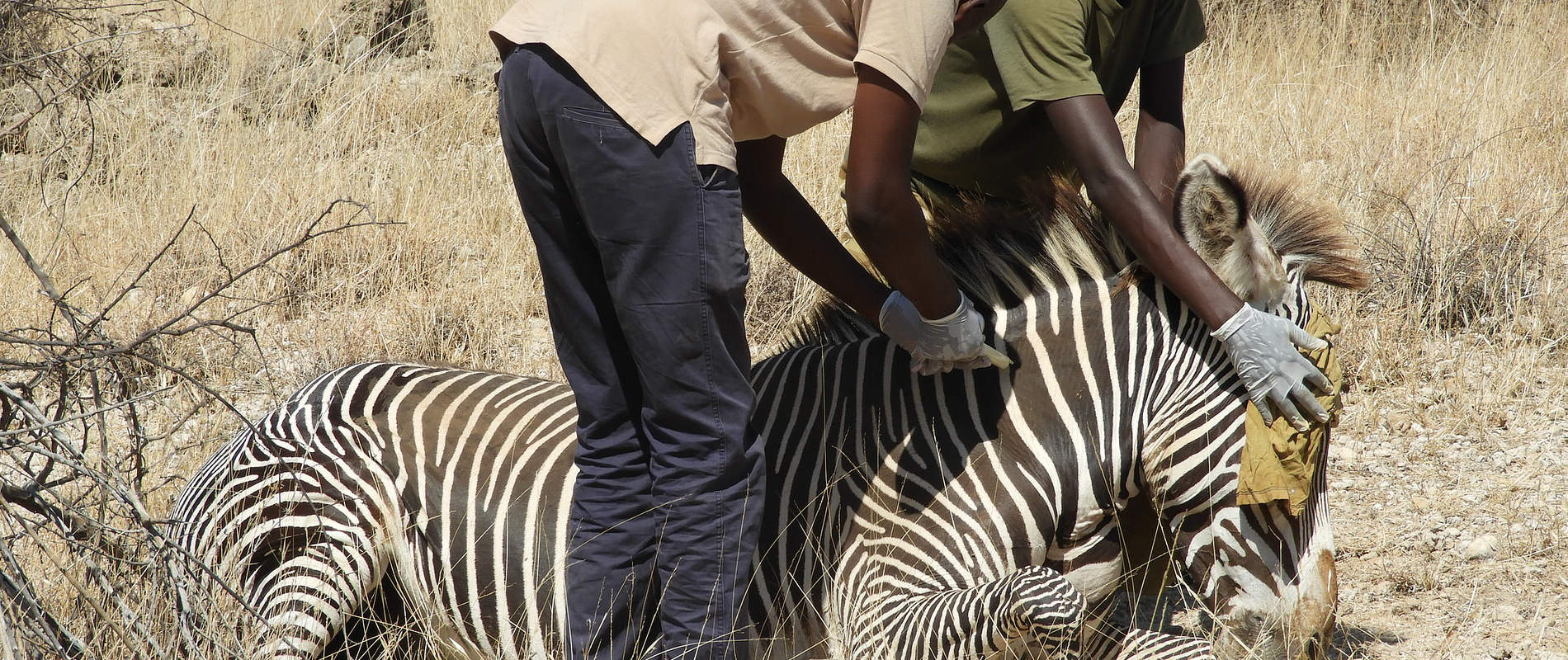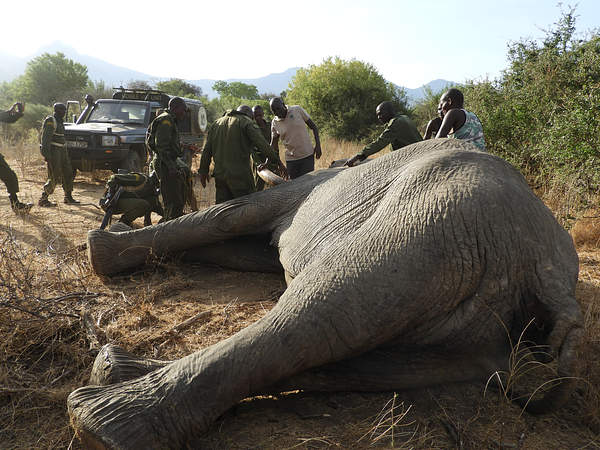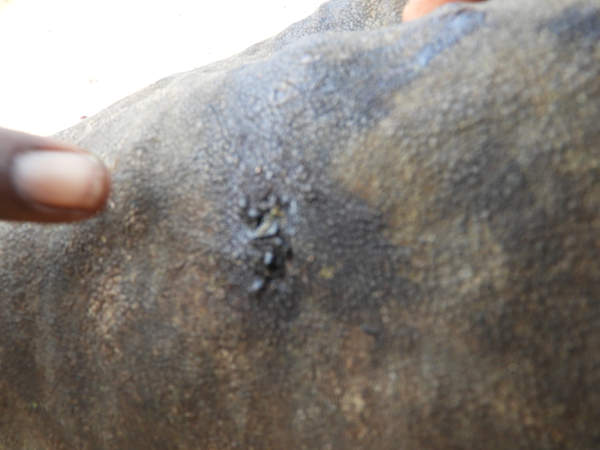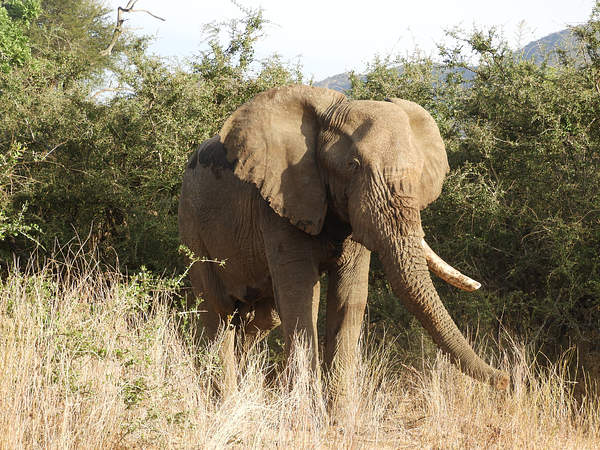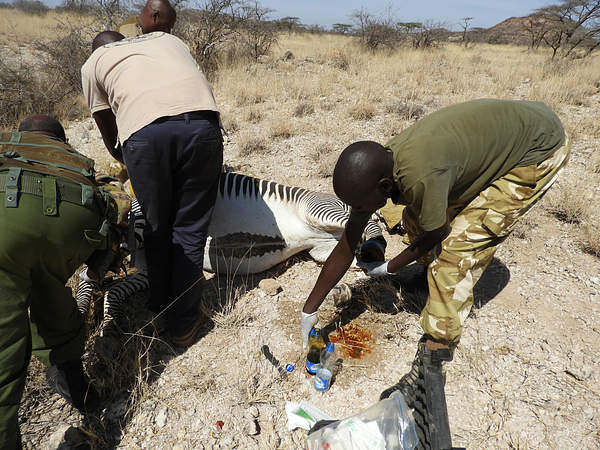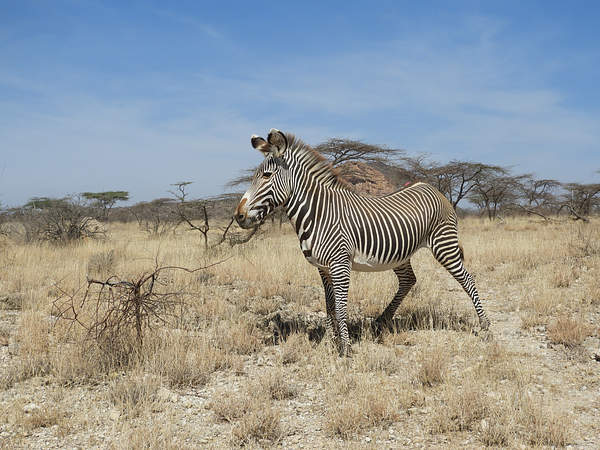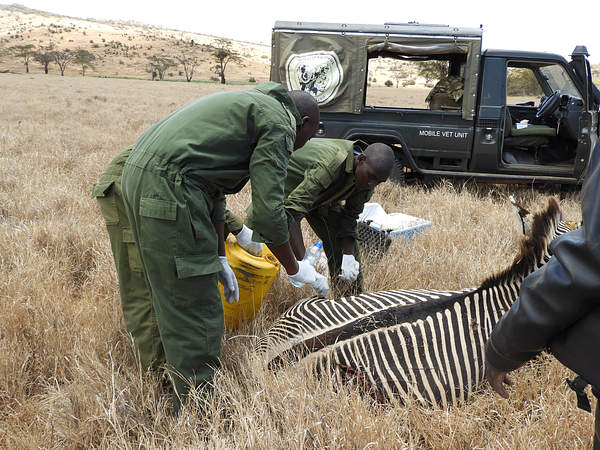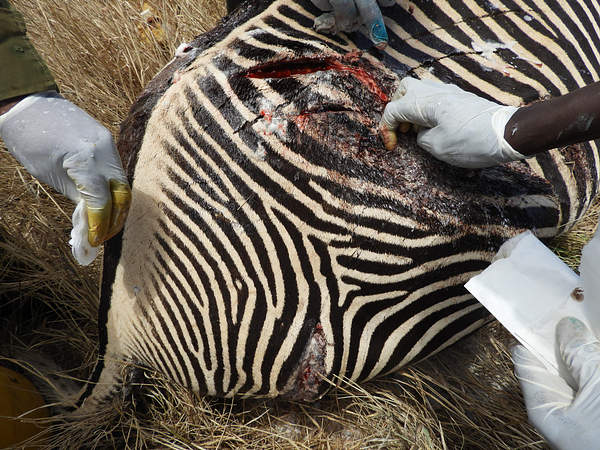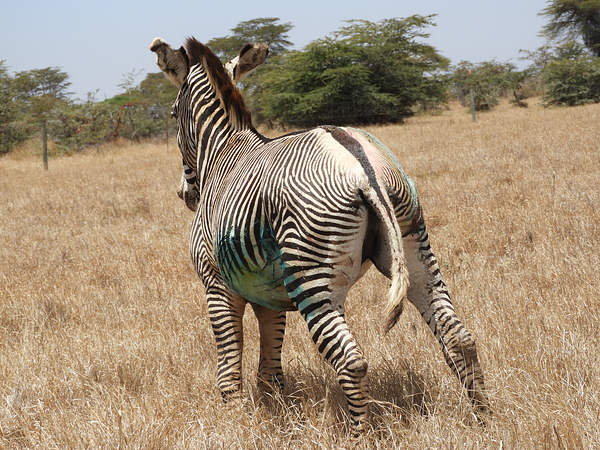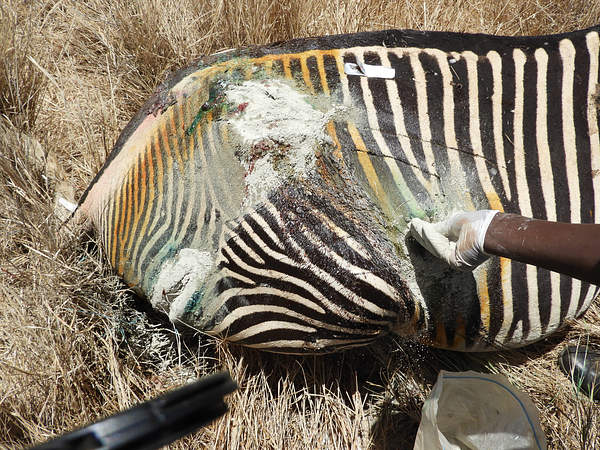Covering Meru National Park, Bisanadi National Reserve and Kora National Reserve, including all wildlife dispersal areas around the Eastern and Northern Conservation Areas.
CASE#1 POST MORTEM EXAMINATION OF A LIONESS
Date: 3 September 2018
Species: Lion
Sex: Female
Location: Meru National Park
A lioness in Meru National Park showed staggering gait characterized by swaying of the hind quarter. Initial observation showed it was in good body condition and the pride had a buffalo kill. No intervention was carried was. It was found dead 7 days later and having moved a short distance from where it was initially observed.

A post mortem examination of the carcass showed it died from internal injuries in the visceral organs and vertebrae believed to have been sustained while hunting.
CASE#2 NECK INJURY IN A RETICULATED GIRAFFE
Date: 7 September 2018
Species: Reticulated giraffe
Sex: Male
Location: Leparua conservancy
This male giraffe in Leparua Conservancy showed a kinked neck for two weeks. It had difficulty feeding with loss of its body condition. The conservancy sought veterinary advice on the health and welfare of this giraffe.

The cause of the kinked neck in this giraffe is believed to be trauma with injury to the cervical vertebrae. This condition is referred to as scoliosis. No intervention was carried out but the conservancy was advised to monitor it and report on its health progress. It is likely that the injury will heal with chronic deformity of the cervical vertebrae.
CASE #3: CAPTURE AND RELOCATION OF A LEOPARD
Date: 8 September 2018
Species: Leopard Sex: Male
Capture site: Marania farm, Mount Kenya
Release site: Meru National Park
Capture, examination and treatment: This leopard is reported to have been responsible for livestock losses in Marania farm and surrounding community land. A cage trap was deployed to capture the leopard and later transported by road to Meru National Park. The leopard was immobilized to treat a wound on its leg and fit a satellite tracking collar for monitoring. It was immobilized using a combination of Ketamine Hydrochloride and Medetomidine Hydrochloride. Examination showed an amputated claw on its left front paw. This was treated by washing, application of topical antibiotics and injection of antibiotics.

Reversal and release: Effect of Medetomidine was reversed ninety minutes after darting. The leopard was later released in the park. Data from the collar shows it has since settled well within the park and its activity has increased progressively showing it is recovering well from the injuries.
CASE#4 LAMENESS IN ELEPHANT
Date: 11 September 2018
Species: Elephant
Sex: Male
Location: Milgis, Samburu north
History: Scouts from the Milgis Trust reported that an elephant bull in Milgis showed lameness and swelling on its front leg with limited movement for 5 days.
Immobilization, examination and treatment: We darted this elephant to investigate the cause of lameness and treat the injury if any. The elephant was found in a thick bush with thick undergrowth which was only accessible by helicopter provided by the Lewa Wildlife Conservancy. It was driven out of the bush and a dart containing Etorphine Hydrochloride was delivered into the gluteal muscles. Examination revealed inflammation of the soft tissue on the left carpal joint suspected to have been sustained in rough hilly terrain. No external injuries or wounds were found. Anti inflammatory drugs and antibiotics were administered.
Reversal and prognosis: Diprenophine Hydrochloride injected to reverse effect of narcotics. This elephant is expected to make a complete recovery.
Our Mobile Vet Units are in the field every day saving wild lives
CASE#5 INJURED ELEPHANT IN NAMUNYAK CONSERVANCY
Date: 12 September 2018
Species: Elephant
Sex: Male
Location: Sarara lodge, Namunyak conservancy
History: Rangers from the Northern Rangeland Trust (NRT) reported an elephant bull which was bleeding on its left front leg. It was suspected to have sustained gunshot injuries on the leg. We immobilized this elephant to determine the cause of this injury.

Immobilization, examination and treatment: Immobilization was achieved using Etorphine Hydrochloride delivered in a 3cc Daninject dart into the rump. Six minutes later the elephant which fell on sternal recumbency was positioned to right lateral recumbence for examination. We found a tear on the left ear flap caused by trauma with blood dripping on the left front leg. No other serious injury was found. Wound was washed and topical antibiotics applied. Anti inflammatory drugs were injected.
Reversal and prognosis: The anesthesia was reversed intravenously with Diprenophine hydrochloride. This elephant is expected to recover from this minor injury soon.
CASE#6 PODODERMATITIS IN A GREVY ZEBRA
Date: 13 September 2018
Species: Grevy zebra
Sex: Female
Location: Shaba National Reserve
History: Rangers on patrol in the Shaba National Reserve reported a pregnant grevy zebra with lameness and swelling on its front leg. It was observed over a period of four days but showed no improvement. When we visited the reserve we found the zebra at the periphery of a herd.
Immobilization, examination and treatment: Darting was done by vehicle. A single 1.5 cc dart containing Etorphine Hydrochloride and Azaperone was delivered into the gluteal muscle. Induction time was six minutes; later the zebra fell onto sternal recumbency. A blindfold was applied to minimize visual stress.
Examination showed cracks on the caudal aspect of the right front hoof with inflammation on the coronary band and the frog. This condition was diagnosed as pododermatitis. Hoof cracks were trimmed and necrotic tissue on the frog debridded physically. It was scrubbed thoroughly with diluted Hydrogen Peroxide and Povidone Iodine was applied. Systemic antibiotics and anti inflammatory drugs were injected.
Reversal and prognosis: After treatment Diprenophine Hydrochloride was injected intravenously to reverse the effect of narcotics.

The zebra was on standing position two minutes later and trotted away to join the rest of the herd. It is expected to make a full recovery.
CASE#7: PREDATION WOUNDS IN A GREVY ZEBRA
Date: 15 September 2018
Species: Grevy zebra
Sex: Male
Location: Lewa Wildlife Conservancy (LWC)
History: This grevy zebra stallion sustained injuries on the hind quarters and abdomen in an attack by lions. We found it in a group of 8 zebra near a swamp in Lewa Wildlife Conservancy.
Immobilization, examination and treatment: Chemical immobilization was achieved using a combination of Etorphine Hcl and Azaperone Tartate in a single 1.5cc DanInject dart. Induction time was four minutes.

Examination revealed puncture wounds cranial to the left thigh and lacerations on the right dorsal rump and flank. The wounds were septic and at least 4 days old. Bruises were also observed on the flanks. The wounds were shaved and washed to remove foreign material. They were debrided using diluted Hydrogen Peroxide and Povidone Iodine applied. Green clay was also applied. A long acting antibiotic was injected to treat sepsis.
Reversal and prognosis: Effect of Etorphine Hcl was reversed by intravenous injection of Diprenophine hydrochloride. Two minutes later the male was standing up and ran to join the rest of the herd. It is expected to make a complete recovery in the coming days.
CASE#8 DISPOSAL OF AFRICAN CIVET CARCASS
Date: 13 September 2018
Species: African civet
Sex: Female
Location: Shaba National Reserve
An African civet cat was found dead by the road side in Shaba National Reserve. It had fracture on the hind legs and hemorrhage from the nostrils caused by a motor accident.

We collected tissue samples from the external ear pinna for DNA preserved in ethanol and disposed of the carcass.
CASE#9 TREATMENT OF A SYKES MONKEY AT MERU MUSEUM
Date: 20 September 2018
Species: Sykes monkey
Sex: Female
Location: National Museum of Kenya, Meru
History: A captive sykes monkey at the National Museums of Kenya in Meru was reported to have shown reduced appetite, mucous discharge from the nostrils and lesions on the nose and ventral abdomen for 2 weeks.
Immobilization and examination: Anesthesia was achieved using 30mg Ketamine Hydrochloride administered remotely using DanInject system. Induction time was 8 minutes. Examination showed purulent nasal discharge, difficulty breathing and vesicular lesions on the nasal septum and ventral abdomen.

The cause of this upper respiratory tract infection could not be determined from the clinical signs. The sykes monkey was given the following medication: Betamox trihydrate LA 150mg administered intramuscularlyTablets Betamox 40mg to be taken once daily for 5 daysIvermectin parenteral
Prognosis: Prognosis for this case is guarded. The management was advised to isolate this monkey from other primates to prevent cross infection. A review will be conducted after 2 weeks.
Acknowledgement
Report by KWS Vet Dr Rono. The unit would like to thank Kenya Wildlife Service Management for supporting operations of the Meru Veterinary Unit
.
